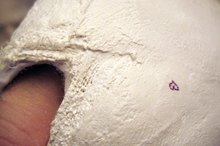An orthopedic cast on a patient's arm, despite limiting his lifestyle, will help a broken bone heal much faster than without one. Modern casts are made out of fiberglass, which is very stiff and keeps the patient's arm immovable and thus more able to heal. Fiberglass casts can have a waterproof liner placed just under the outside fiberglass layer 1. Once the injury heals and the cast is no longer necessary, it can be removed easily by a doctor or at home. The doctor will use a small, electrical medical saw to cut off the cast. Saws will easily cut through all cast types (including the waterproof layer in fiberglass casts) but will only tickle the person's arm 1. At home, soaking a cast in a solution of water and vinegar will slowly dissolve the cast.
If you are experiencing serious medical symptoms, seek emergency treatment immediately.
Sawing
If the cast you are removing is made of plaster, place goggles and breathing mask on yourself and the patient. During sawing, dust can get in your eyes and mouth. Many saws, however, have built-in vacuums, which lessen this hazard.
How to Remove a Cast
Learn More
Start sawing at the top of the arm (the shoulder or elbow) in the direction of the hands.
Saw one side along the arm until cut, and then saw the opposite side.
Most Common Side Effects After Hip Replacement Surgery
Learn More
Saw with an up and down motion to keep the saw from getting jammed or stuck. Grasp the saw handle close to the saw blade for maximum control.
Remove the cast with a cast spreader. It will come off easily because the cast is in two pieces due to cutting it on opposite sides.
Cut away the padding, or stockinet, with scissors. Start at the top of the arm towards the hand.
Use rubbing alcohol on a piece of cotton wool to clean the arm. It will wash away dead skin and dirt build-up. Dispose of the cast immediately.
- If the cast you are removing is made of plaster, place goggles and breathing mask on yourself and the patient.
- Saw with an up and down motion to keep the saw from getting jammed or stuck.
Soaking
Find a bucket large enough for your whole cast to fit in. Fill it with warm water and 1 tbl. of vinegar.
Soak the cast-clad arm for one to two hours until the wrapping starts to loosen. Unwrap the cast until it is completely removed. Dispose of the cast.
Dispose of the water outside, rather than pouring it down your sink; the plaster can clog your pipes.
Warnings
Only let a doctor saw off your cast. Do not attempt to do it yourself.
- Find a bucket large enough for your whole cast to fit in.
- Soak the cast-clad arm for one to two hours until the wrapping starts to loosen.
Related Articles
References
- Orthopaedic Product News. Breaking the mould in cast removal.
- Stork NC, Lenhart RL, Nemeth BA, Noonan KJ, Halanski MA. To cast, to saw, and not to injure: can safety strips decrease cast saw injuries?. Clin Orthop Relat Res. 2016;474(7):1543–1552. doi:10.1007/s11999-016-4723-5
- Shore BJ, Hutchinson S, Harris M, et al. Epidemiology and prevention of cast saw injuries: results of a quality improvement program at a single institution. J Bone Joint Surg Am. 2014;96(4):e31. doi:10.2106/JBJS.L.01372
- Shore BJ, et al. "Epidemiology and Prevention of Cast Saw Injuries: Results of a Quality Improvement Program at a Single Institution" J Bone Joint Surg Am, 2014 Feb 19;96(4):e31 1-8.
- Shuler FD and Grisafi FN. "Cast-saw burns: evaluation of skin, cast, and blade temperatures generated during cast removal" J Bone Joint Surg Am. 2008 Dec;90(12):2626-30.
Writer Bio
Hayley Smith is a freelance documentary filmmaker and writer with a Bachelor of Arts in English and a Master of Arts in Middle Eastern studies. She has contributed written work to various websites, specializing in topics on the outdoors and Utah skiing.









